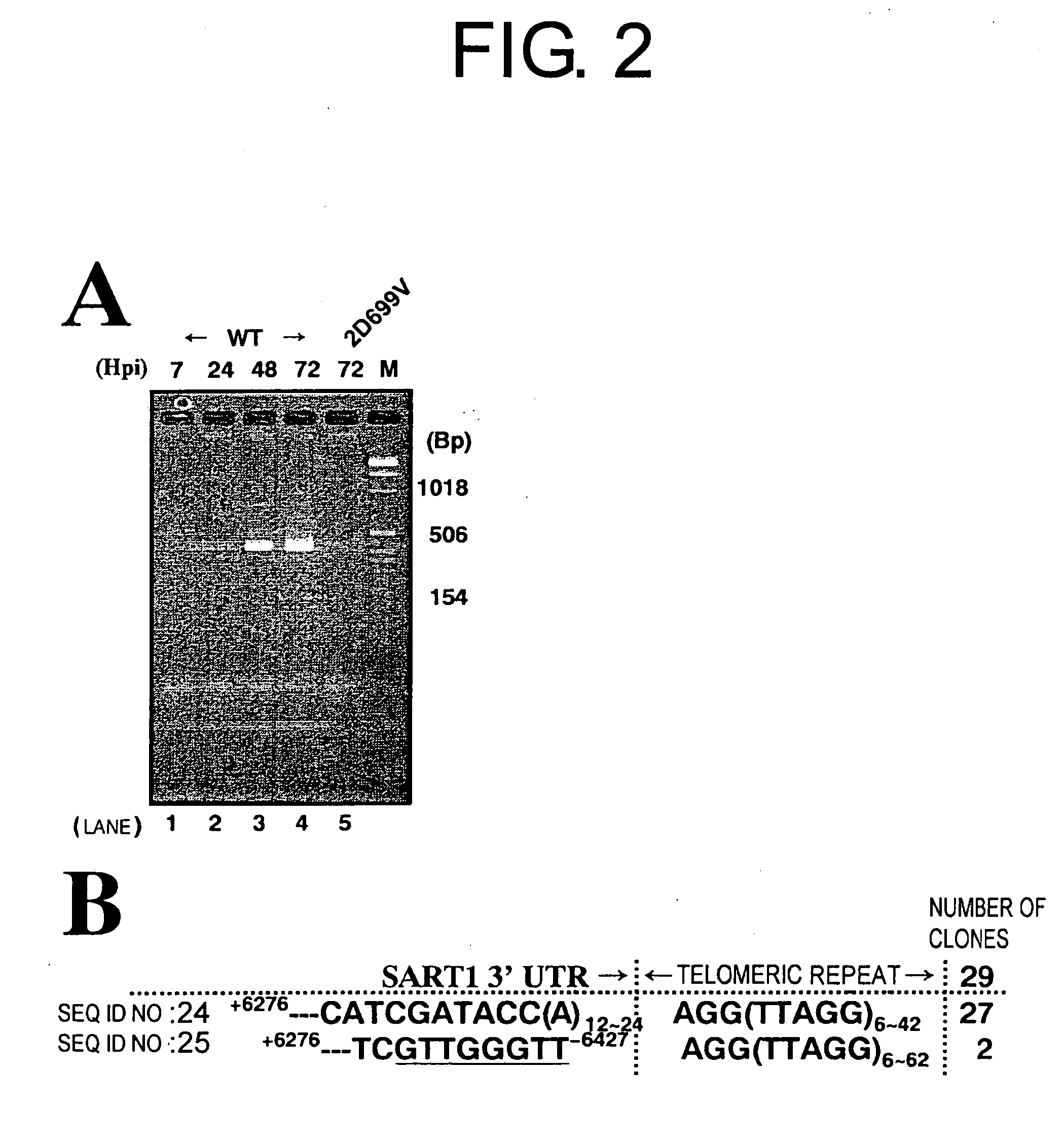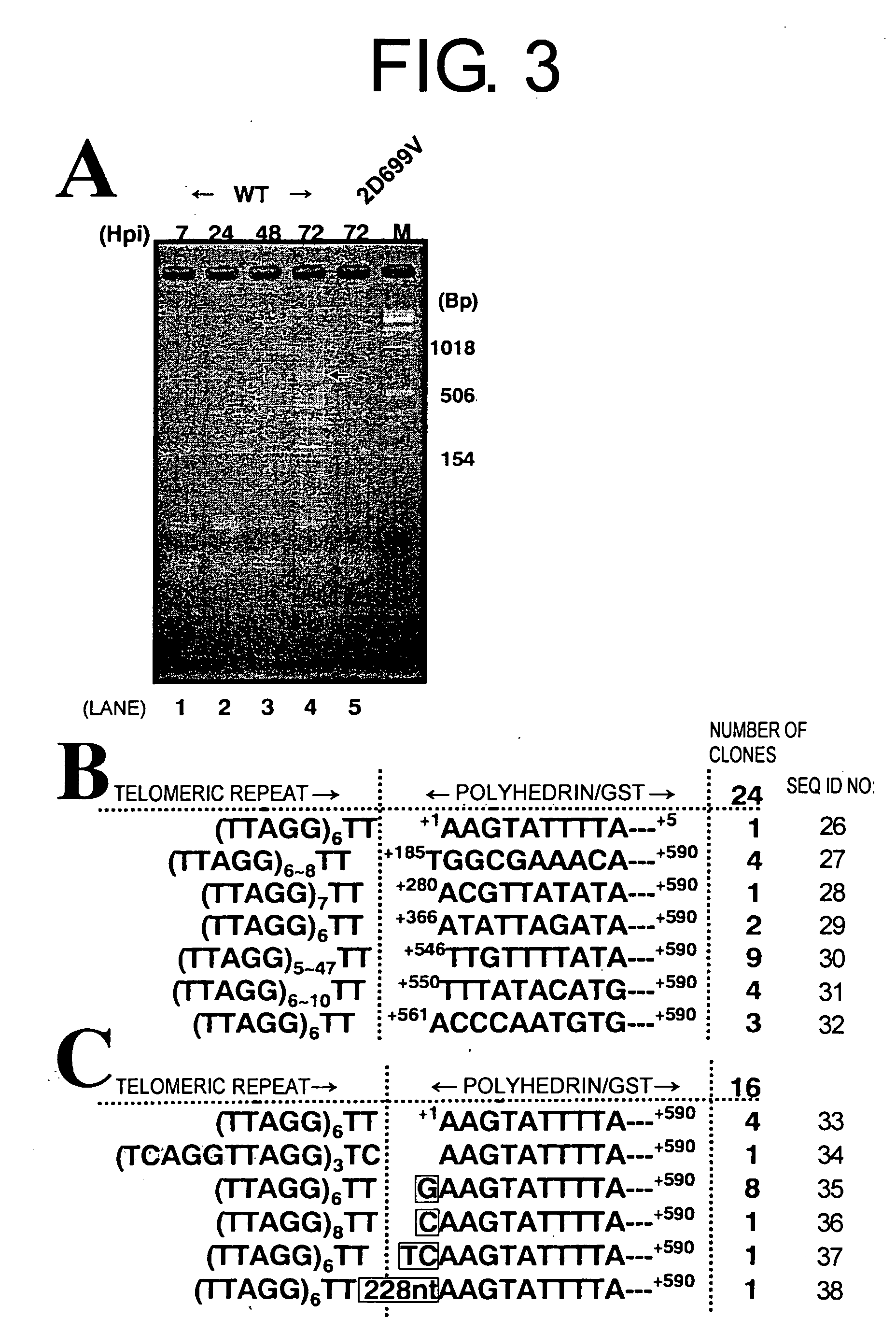Methods for retrotransposing long interspersed elements (lines)
- Summary
- Abstract
- Description
- Claims
- Application Information
AI Technical Summary
Benefits of technology
Problems solved by technology
Method used
Image
Examples
example 1
Plasmid Construction
[0083] The SART1 ORF1 / ORF2 / 3′UTR portion was amplified by PCR from the genomic library clone, BS103 (Takahashi, H. et al. (1997) Nucl. Acids Res., 25, 1578-1584), using a pair of primers, SART1 S880 and SAX 3p Not1 (see Table 1). 30 cycles of PCR was conducted using Pfu Turbo™ DNA polymerase (Stratagene). The PCR product was subcloned between the NcoI and NotI sites of the pAcGHLTB plasmid (Pharmingen). The resulting plasmid, named SART1WT-pAcGHLTB, comprised the 64-bp polyhedrin 5′UTR and the GST-X5-(His)6-X31-coding gene, SART1 ORF1 fused in-frame with MGSYKE--- of this gene (note that the underlined position is serine in the native SART1 ORF), followed by the SART1 / ORF2 / 3′UTR, and the polyhedrin 3′UTR. Point mutations were introduced into SART1WT-pAcGHLTB with four pairs of primers listed in Table 1 using the QuickChange™ Mutagenesis Kit (Stratagene). The SART1 Δ3′-pAcGHLTB was constructed by digesting SART1WT-pAcGHLTB with AfIII and NotI, and ligating betwee...
example 2
Recombinant AcNPV Generation
[0084] Sf9 cells were grown as monolayer cultures at 27° C. in TC-100 medium supplemented with 10% fetal bovine serum (Nihon-nosankougyou) in the presence of penicillin / streptomycin (Gibco). The recombinant baculovirus comprising the wild-type or mutant SART1 ORF1 / ORF2 / 3′ UTR portion driven by the polyhedrin promoter was produced by co-transfection of the wild-type or mutant SART1-pAcGHLTB plasmid with the BaculoGold™ DNA (Pharmingen) into the Sf9 cells using the Tfx-20 lipofection reagent (Promega). Four days later, the medium was collected and used for plaque purification and subsequent virus propagation, according to the manufacturer's instructions (Pharmingen).
example 3
Detection of In Vivo SART1 Retrotransposition by PCR Assay
[0085] To detect in vivo SART1 retrotransposition, SART1 was expressed from AcNPV in Sf9 cells and this was monitored by PCR to see if the silkworm SART1 transposed into the Sf9 chromosomal telomeric repeats (FIG. 1A). In the recombinant AcNPV of Example 2, used in this heterologous expression system, the SART1 ORF1 / ORF2 / 3′UTR portion is placed under the control of the AcNPV polyhedrin promoter (FIG. 1B, top). For future biochemical analysis, the SART1 ORF1 was fused to the C-terminal of GST-X5-(His)6-X31 (X denotes the vector-derived amino acid) with the position of ORF2 / 3′UTR kept native relative to ORF1 (see Example 1). SDS-PAGE of the Sf9 total proteins confirmed that each virus expressed the putative GST-HiS6-SART1 ORF1-fused protein, which is approximately 110 kDa in molecular weight (data not shown).
[0086] In vivo retrotransposition assays by PCR was performed as follows: Approximately 1×106 Sf9 cells were infected i...
PUM
 Login to View More
Login to View More Abstract
Description
Claims
Application Information
 Login to View More
Login to View More - R&D
- Intellectual Property
- Life Sciences
- Materials
- Tech Scout
- Unparalleled Data Quality
- Higher Quality Content
- 60% Fewer Hallucinations
Browse by: Latest US Patents, China's latest patents, Technical Efficacy Thesaurus, Application Domain, Technology Topic, Popular Technical Reports.
© 2025 PatSnap. All rights reserved.Legal|Privacy policy|Modern Slavery Act Transparency Statement|Sitemap|About US| Contact US: help@patsnap.com



